Strategies for Building Positive Relations at The Warehouse Group
VerifiedAdded on 2023/05/30
|15
|3681
|318
Report
AI Summary
This report discusses strategies for developing positive relationships with stakeholders at The Warehouse Group (TWG) to enhance organizational flexibility and adapt to changing business conditions. It emphasizes the importance of workplace relationships on individual and organizational performance, highlighting strategies for engaging internal stakeholders, such as involving them in vision-sharing and addressing resistance to change. For external stakeholders, the report advocates for regular communication and prompt issue resolution. It also examines the impact of ethical and cultural behaviors on customer service and proposes using design thinking methodologies to improve customer service response systems within TWG. The report references TWG's use of the 'Financial Performance Indicator' and Total Response Cost (TRC) for evaluating customer responses and improving financial aspects.
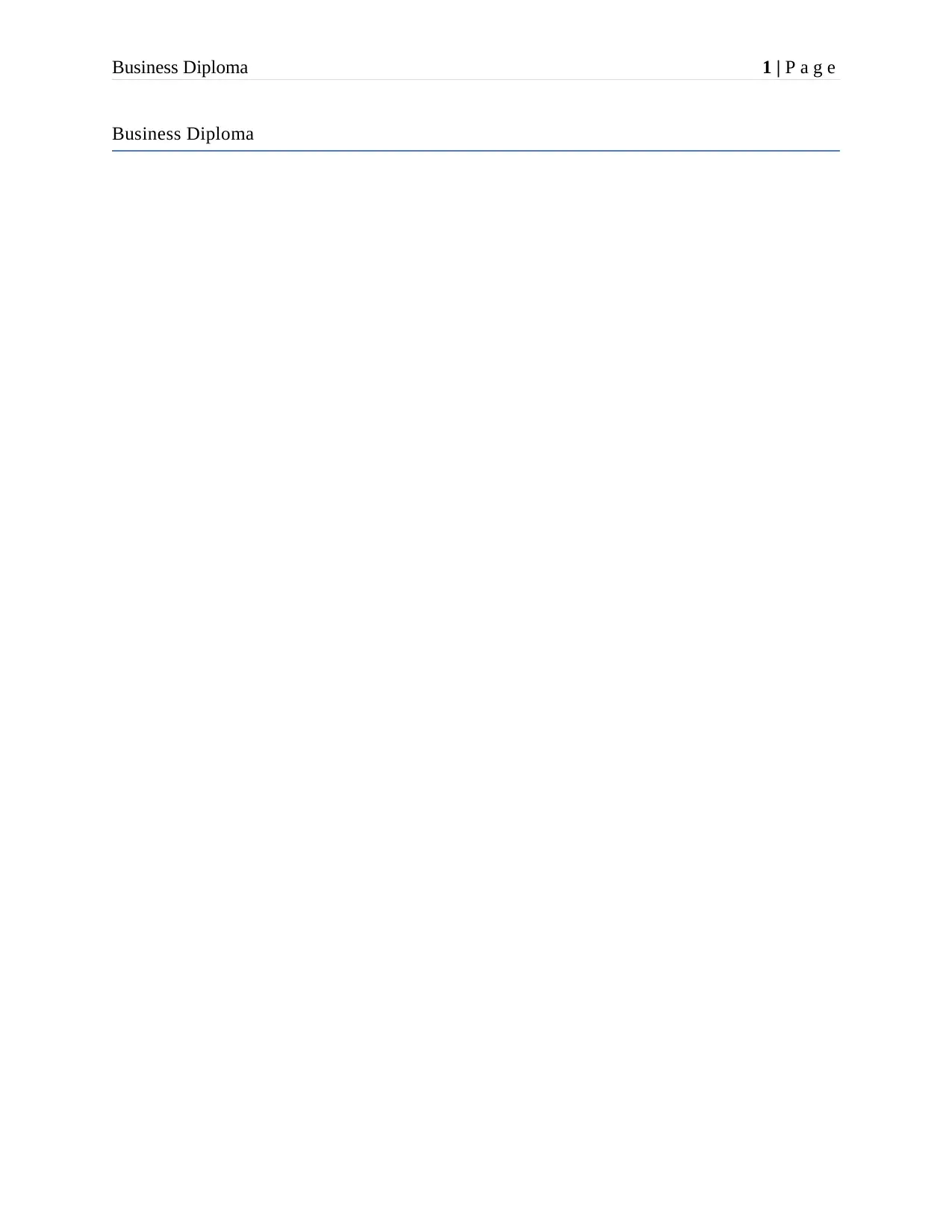
Business Diploma 1 | P a g e
Business Diploma
Business Diploma
Paraphrase This Document
Need a fresh take? Get an instant paraphrase of this document with our AI Paraphraser
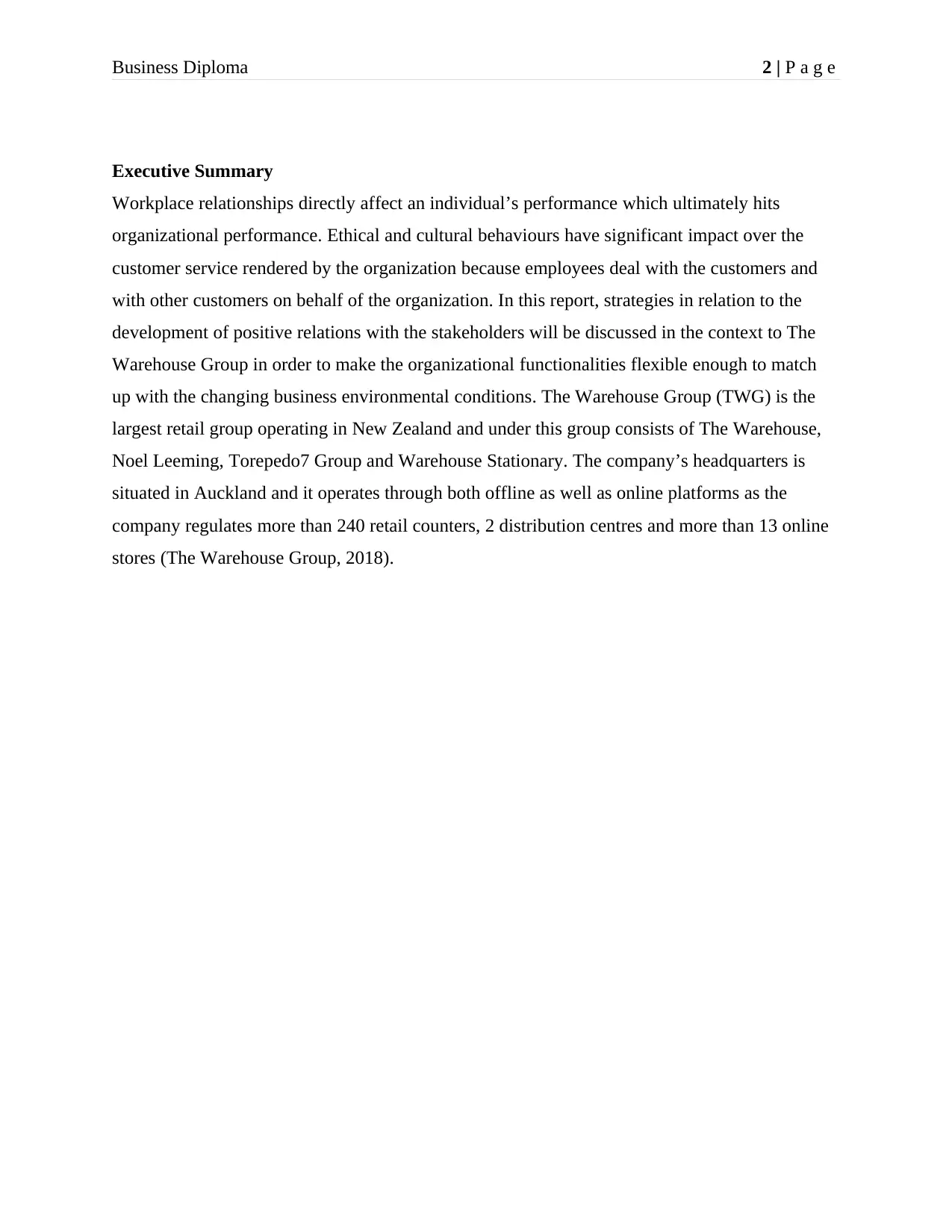
Business Diploma 2 | P a g e
Executive Summary
Workplace relationships directly affect an individual’s performance which ultimately hits
organizational performance. Ethical and cultural behaviours have significant impact over the
customer service rendered by the organization because employees deal with the customers and
with other customers on behalf of the organization. In this report, strategies in relation to the
development of positive relations with the stakeholders will be discussed in the context to The
Warehouse Group in order to make the organizational functionalities flexible enough to match
up with the changing business environmental conditions. The Warehouse Group (TWG) is the
largest retail group operating in New Zealand and under this group consists of The Warehouse,
Noel Leeming, Torepedo7 Group and Warehouse Stationary. The company’s headquarters is
situated in Auckland and it operates through both offline as well as online platforms as the
company regulates more than 240 retail counters, 2 distribution centres and more than 13 online
stores (The Warehouse Group, 2018).
Executive Summary
Workplace relationships directly affect an individual’s performance which ultimately hits
organizational performance. Ethical and cultural behaviours have significant impact over the
customer service rendered by the organization because employees deal with the customers and
with other customers on behalf of the organization. In this report, strategies in relation to the
development of positive relations with the stakeholders will be discussed in the context to The
Warehouse Group in order to make the organizational functionalities flexible enough to match
up with the changing business environmental conditions. The Warehouse Group (TWG) is the
largest retail group operating in New Zealand and under this group consists of The Warehouse,
Noel Leeming, Torepedo7 Group and Warehouse Stationary. The company’s headquarters is
situated in Auckland and it operates through both offline as well as online platforms as the
company regulates more than 240 retail counters, 2 distribution centres and more than 13 online
stores (The Warehouse Group, 2018).
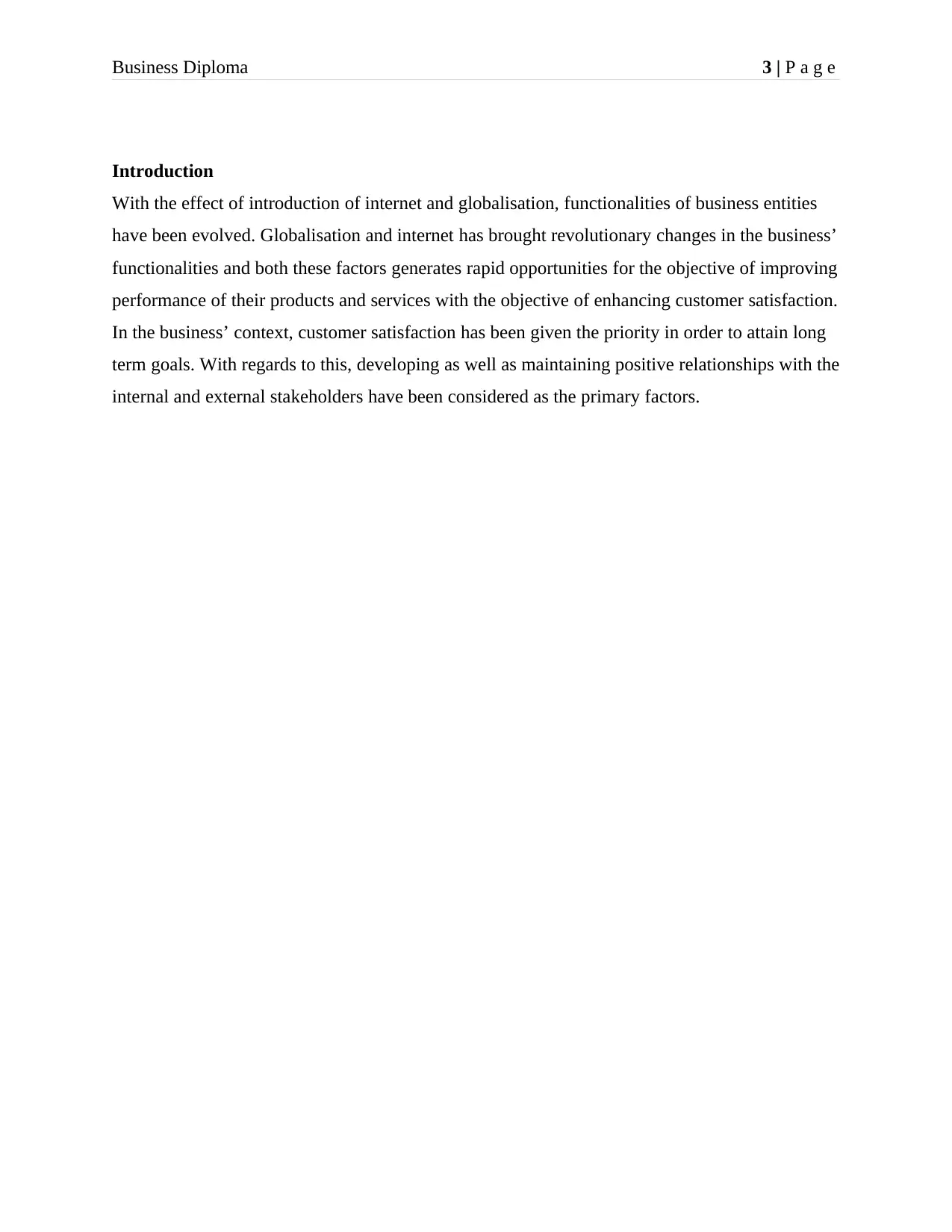
Business Diploma 3 | P a g e
Introduction
With the effect of introduction of internet and globalisation, functionalities of business entities
have been evolved. Globalisation and internet has brought revolutionary changes in the business’
functionalities and both these factors generates rapid opportunities for the objective of improving
performance of their products and services with the objective of enhancing customer satisfaction.
In the business’ context, customer satisfaction has been given the priority in order to attain long
term goals. With regards to this, developing as well as maintaining positive relationships with the
internal and external stakeholders have been considered as the primary factors.
Introduction
With the effect of introduction of internet and globalisation, functionalities of business entities
have been evolved. Globalisation and internet has brought revolutionary changes in the business’
functionalities and both these factors generates rapid opportunities for the objective of improving
performance of their products and services with the objective of enhancing customer satisfaction.
In the business’ context, customer satisfaction has been given the priority in order to attain long
term goals. With regards to this, developing as well as maintaining positive relationships with the
internal and external stakeholders have been considered as the primary factors.
⊘ This is a preview!⊘
Do you want full access?
Subscribe today to unlock all pages.

Trusted by 1+ million students worldwide
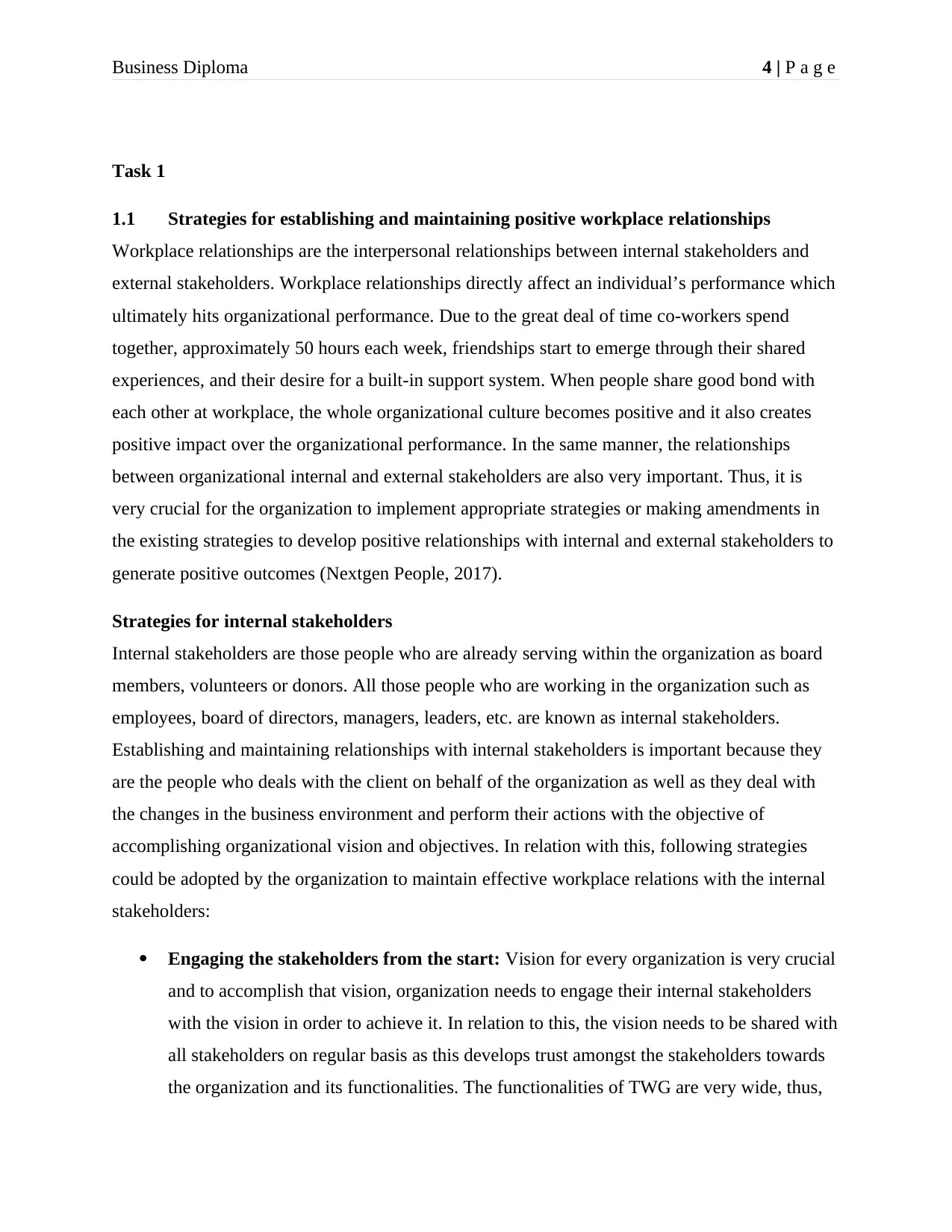
Business Diploma 4 | P a g e
Task 1
1.1 Strategies for establishing and maintaining positive workplace relationships
Workplace relationships are the interpersonal relationships between internal stakeholders and
external stakeholders. Workplace relationships directly affect an individual’s performance which
ultimately hits organizational performance. Due to the great deal of time co-workers spend
together, approximately 50 hours each week, friendships start to emerge through their shared
experiences, and their desire for a built-in support system. When people share good bond with
each other at workplace, the whole organizational culture becomes positive and it also creates
positive impact over the organizational performance. In the same manner, the relationships
between organizational internal and external stakeholders are also very important. Thus, it is
very crucial for the organization to implement appropriate strategies or making amendments in
the existing strategies to develop positive relationships with internal and external stakeholders to
generate positive outcomes (Nextgen People, 2017).
Strategies for internal stakeholders
Internal stakeholders are those people who are already serving within the organization as board
members, volunteers or donors. All those people who are working in the organization such as
employees, board of directors, managers, leaders, etc. are known as internal stakeholders.
Establishing and maintaining relationships with internal stakeholders is important because they
are the people who deals with the client on behalf of the organization as well as they deal with
the changes in the business environment and perform their actions with the objective of
accomplishing organizational vision and objectives. In relation with this, following strategies
could be adopted by the organization to maintain effective workplace relations with the internal
stakeholders:
Engaging the stakeholders from the start: Vision for every organization is very crucial
and to accomplish that vision, organization needs to engage their internal stakeholders
with the vision in order to achieve it. In relation to this, the vision needs to be shared with
all stakeholders on regular basis as this develops trust amongst the stakeholders towards
the organization and its functionalities. The functionalities of TWG are very wide, thus,
Task 1
1.1 Strategies for establishing and maintaining positive workplace relationships
Workplace relationships are the interpersonal relationships between internal stakeholders and
external stakeholders. Workplace relationships directly affect an individual’s performance which
ultimately hits organizational performance. Due to the great deal of time co-workers spend
together, approximately 50 hours each week, friendships start to emerge through their shared
experiences, and their desire for a built-in support system. When people share good bond with
each other at workplace, the whole organizational culture becomes positive and it also creates
positive impact over the organizational performance. In the same manner, the relationships
between organizational internal and external stakeholders are also very important. Thus, it is
very crucial for the organization to implement appropriate strategies or making amendments in
the existing strategies to develop positive relationships with internal and external stakeholders to
generate positive outcomes (Nextgen People, 2017).
Strategies for internal stakeholders
Internal stakeholders are those people who are already serving within the organization as board
members, volunteers or donors. All those people who are working in the organization such as
employees, board of directors, managers, leaders, etc. are known as internal stakeholders.
Establishing and maintaining relationships with internal stakeholders is important because they
are the people who deals with the client on behalf of the organization as well as they deal with
the changes in the business environment and perform their actions with the objective of
accomplishing organizational vision and objectives. In relation with this, following strategies
could be adopted by the organization to maintain effective workplace relations with the internal
stakeholders:
Engaging the stakeholders from the start: Vision for every organization is very crucial
and to accomplish that vision, organization needs to engage their internal stakeholders
with the vision in order to achieve it. In relation to this, the vision needs to be shared with
all stakeholders on regular basis as this develops trust amongst the stakeholders towards
the organization and its functionalities. The functionalities of TWG are very wide, thus,
Paraphrase This Document
Need a fresh take? Get an instant paraphrase of this document with our AI Paraphraser
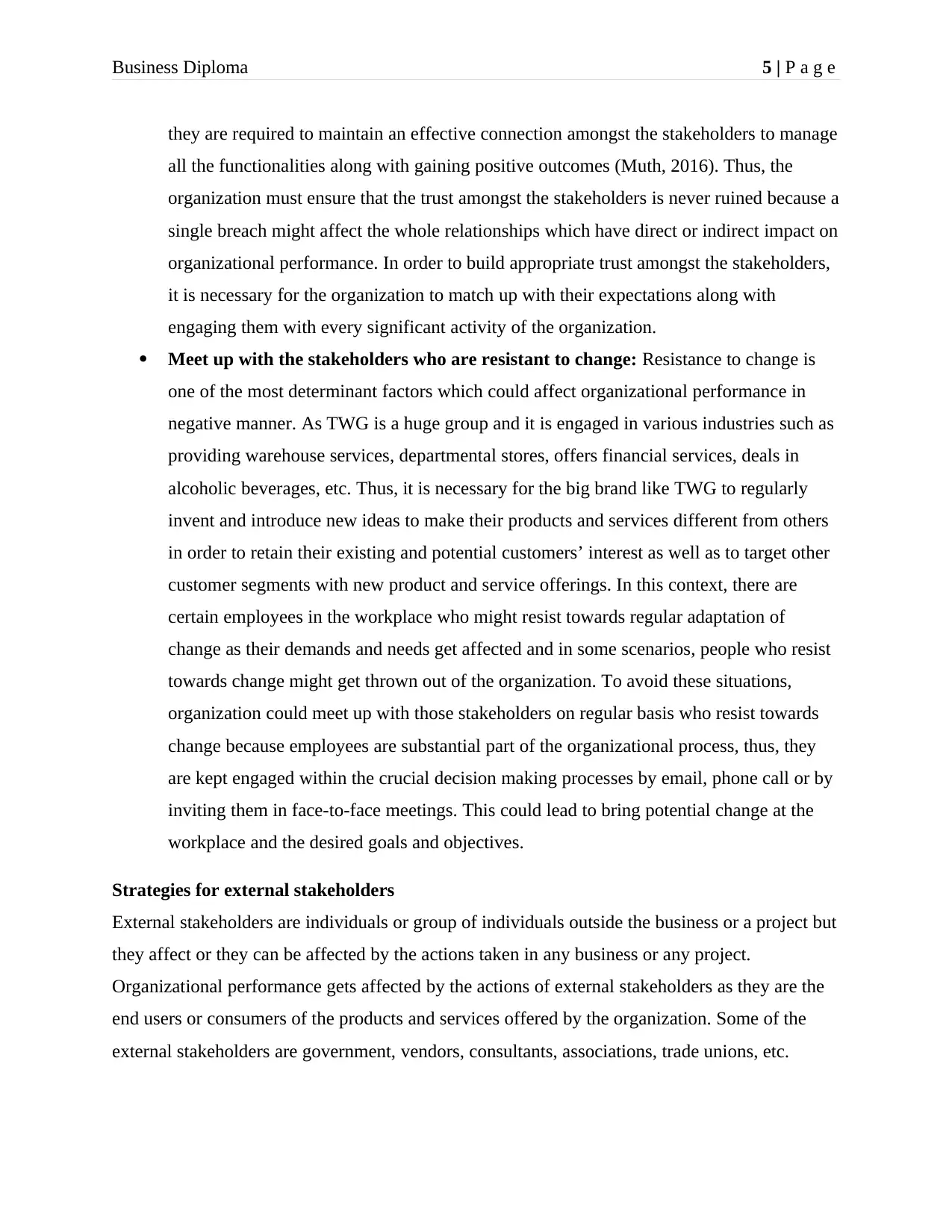
Business Diploma 5 | P a g e
they are required to maintain an effective connection amongst the stakeholders to manage
all the functionalities along with gaining positive outcomes (Muth, 2016). Thus, the
organization must ensure that the trust amongst the stakeholders is never ruined because a
single breach might affect the whole relationships which have direct or indirect impact on
organizational performance. In order to build appropriate trust amongst the stakeholders,
it is necessary for the organization to match up with their expectations along with
engaging them with every significant activity of the organization.
Meet up with the stakeholders who are resistant to change: Resistance to change is
one of the most determinant factors which could affect organizational performance in
negative manner. As TWG is a huge group and it is engaged in various industries such as
providing warehouse services, departmental stores, offers financial services, deals in
alcoholic beverages, etc. Thus, it is necessary for the big brand like TWG to regularly
invent and introduce new ideas to make their products and services different from others
in order to retain their existing and potential customers’ interest as well as to target other
customer segments with new product and service offerings. In this context, there are
certain employees in the workplace who might resist towards regular adaptation of
change as their demands and needs get affected and in some scenarios, people who resist
towards change might get thrown out of the organization. To avoid these situations,
organization could meet up with those stakeholders on regular basis who resist towards
change because employees are substantial part of the organizational process, thus, they
are kept engaged within the crucial decision making processes by email, phone call or by
inviting them in face-to-face meetings. This could lead to bring potential change at the
workplace and the desired goals and objectives.
Strategies for external stakeholders
External stakeholders are individuals or group of individuals outside the business or a project but
they affect or they can be affected by the actions taken in any business or any project.
Organizational performance gets affected by the actions of external stakeholders as they are the
end users or consumers of the products and services offered by the organization. Some of the
external stakeholders are government, vendors, consultants, associations, trade unions, etc.
they are required to maintain an effective connection amongst the stakeholders to manage
all the functionalities along with gaining positive outcomes (Muth, 2016). Thus, the
organization must ensure that the trust amongst the stakeholders is never ruined because a
single breach might affect the whole relationships which have direct or indirect impact on
organizational performance. In order to build appropriate trust amongst the stakeholders,
it is necessary for the organization to match up with their expectations along with
engaging them with every significant activity of the organization.
Meet up with the stakeholders who are resistant to change: Resistance to change is
one of the most determinant factors which could affect organizational performance in
negative manner. As TWG is a huge group and it is engaged in various industries such as
providing warehouse services, departmental stores, offers financial services, deals in
alcoholic beverages, etc. Thus, it is necessary for the big brand like TWG to regularly
invent and introduce new ideas to make their products and services different from others
in order to retain their existing and potential customers’ interest as well as to target other
customer segments with new product and service offerings. In this context, there are
certain employees in the workplace who might resist towards regular adaptation of
change as their demands and needs get affected and in some scenarios, people who resist
towards change might get thrown out of the organization. To avoid these situations,
organization could meet up with those stakeholders on regular basis who resist towards
change because employees are substantial part of the organizational process, thus, they
are kept engaged within the crucial decision making processes by email, phone call or by
inviting them in face-to-face meetings. This could lead to bring potential change at the
workplace and the desired goals and objectives.
Strategies for external stakeholders
External stakeholders are individuals or group of individuals outside the business or a project but
they affect or they can be affected by the actions taken in any business or any project.
Organizational performance gets affected by the actions of external stakeholders as they are the
end users or consumers of the products and services offered by the organization. Some of the
external stakeholders are government, vendors, consultants, associations, trade unions, etc.
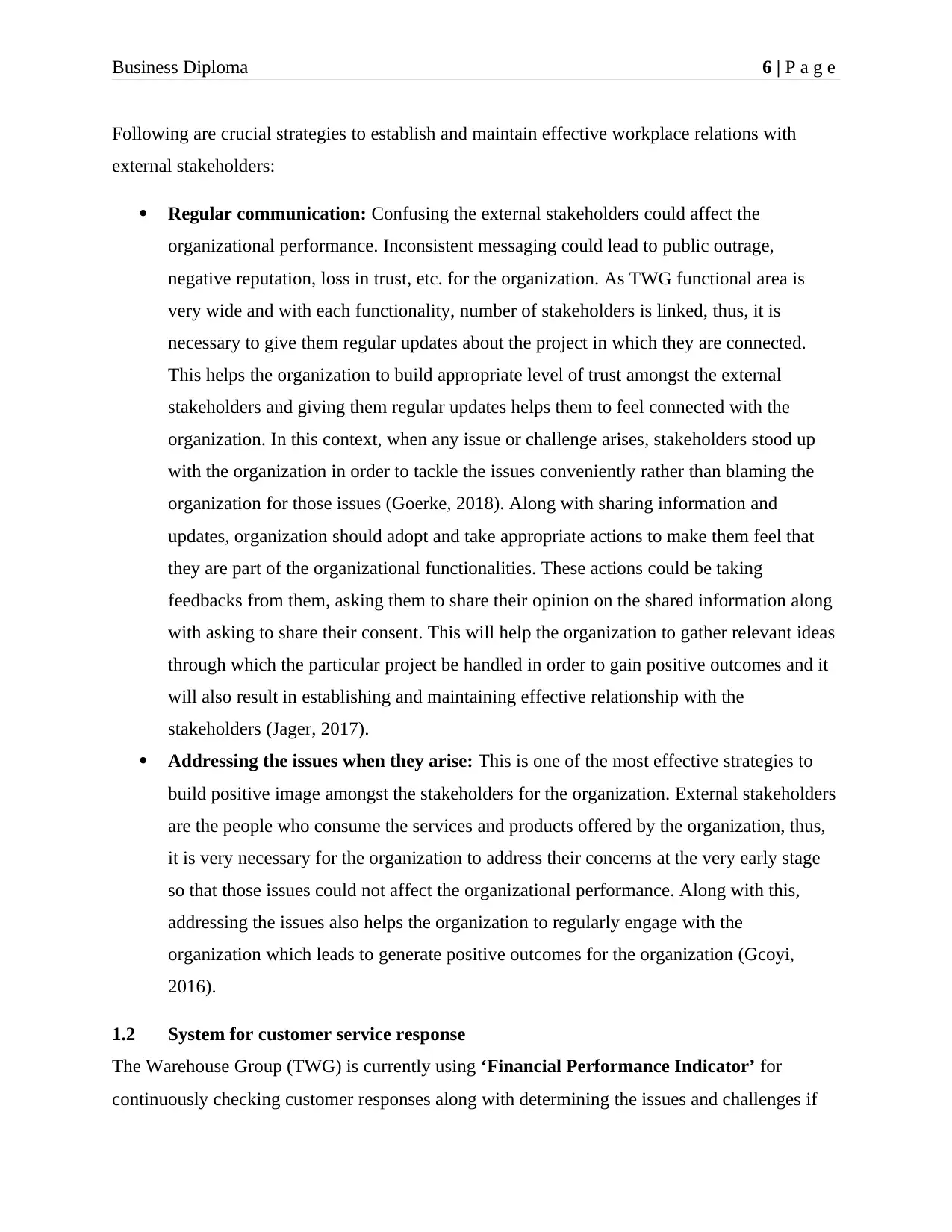
Business Diploma 6 | P a g e
Following are crucial strategies to establish and maintain effective workplace relations with
external stakeholders:
Regular communication: Confusing the external stakeholders could affect the
organizational performance. Inconsistent messaging could lead to public outrage,
negative reputation, loss in trust, etc. for the organization. As TWG functional area is
very wide and with each functionality, number of stakeholders is linked, thus, it is
necessary to give them regular updates about the project in which they are connected.
This helps the organization to build appropriate level of trust amongst the external
stakeholders and giving them regular updates helps them to feel connected with the
organization. In this context, when any issue or challenge arises, stakeholders stood up
with the organization in order to tackle the issues conveniently rather than blaming the
organization for those issues (Goerke, 2018). Along with sharing information and
updates, organization should adopt and take appropriate actions to make them feel that
they are part of the organizational functionalities. These actions could be taking
feedbacks from them, asking them to share their opinion on the shared information along
with asking to share their consent. This will help the organization to gather relevant ideas
through which the particular project be handled in order to gain positive outcomes and it
will also result in establishing and maintaining effective relationship with the
stakeholders (Jager, 2017).
Addressing the issues when they arise: This is one of the most effective strategies to
build positive image amongst the stakeholders for the organization. External stakeholders
are the people who consume the services and products offered by the organization, thus,
it is very necessary for the organization to address their concerns at the very early stage
so that those issues could not affect the organizational performance. Along with this,
addressing the issues also helps the organization to regularly engage with the
organization which leads to generate positive outcomes for the organization (Gcoyi,
2016).
1.2 System for customer service response
The Warehouse Group (TWG) is currently using ‘Financial Performance Indicator’ for
continuously checking customer responses along with determining the issues and challenges if
Following are crucial strategies to establish and maintain effective workplace relations with
external stakeholders:
Regular communication: Confusing the external stakeholders could affect the
organizational performance. Inconsistent messaging could lead to public outrage,
negative reputation, loss in trust, etc. for the organization. As TWG functional area is
very wide and with each functionality, number of stakeholders is linked, thus, it is
necessary to give them regular updates about the project in which they are connected.
This helps the organization to build appropriate level of trust amongst the external
stakeholders and giving them regular updates helps them to feel connected with the
organization. In this context, when any issue or challenge arises, stakeholders stood up
with the organization in order to tackle the issues conveniently rather than blaming the
organization for those issues (Goerke, 2018). Along with sharing information and
updates, organization should adopt and take appropriate actions to make them feel that
they are part of the organizational functionalities. These actions could be taking
feedbacks from them, asking them to share their opinion on the shared information along
with asking to share their consent. This will help the organization to gather relevant ideas
through which the particular project be handled in order to gain positive outcomes and it
will also result in establishing and maintaining effective relationship with the
stakeholders (Jager, 2017).
Addressing the issues when they arise: This is one of the most effective strategies to
build positive image amongst the stakeholders for the organization. External stakeholders
are the people who consume the services and products offered by the organization, thus,
it is very necessary for the organization to address their concerns at the very early stage
so that those issues could not affect the organizational performance. Along with this,
addressing the issues also helps the organization to regularly engage with the
organization which leads to generate positive outcomes for the organization (Gcoyi,
2016).
1.2 System for customer service response
The Warehouse Group (TWG) is currently using ‘Financial Performance Indicator’ for
continuously checking customer responses along with determining the issues and challenges if
⊘ This is a preview!⊘
Do you want full access?
Subscribe today to unlock all pages.

Trusted by 1+ million students worldwide
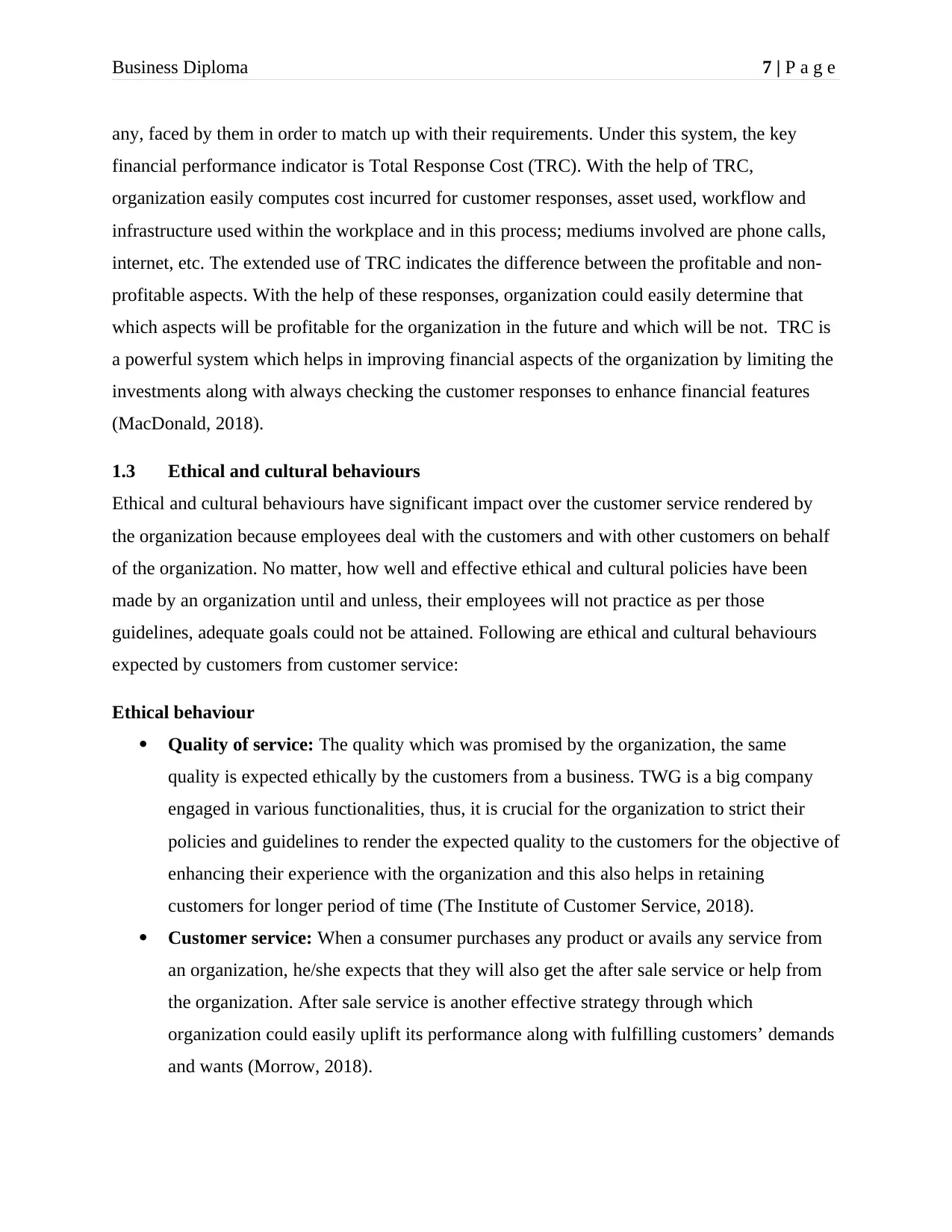
Business Diploma 7 | P a g e
any, faced by them in order to match up with their requirements. Under this system, the key
financial performance indicator is Total Response Cost (TRC). With the help of TRC,
organization easily computes cost incurred for customer responses, asset used, workflow and
infrastructure used within the workplace and in this process; mediums involved are phone calls,
internet, etc. The extended use of TRC indicates the difference between the profitable and non-
profitable aspects. With the help of these responses, organization could easily determine that
which aspects will be profitable for the organization in the future and which will be not. TRC is
a powerful system which helps in improving financial aspects of the organization by limiting the
investments along with always checking the customer responses to enhance financial features
(MacDonald, 2018).
1.3 Ethical and cultural behaviours
Ethical and cultural behaviours have significant impact over the customer service rendered by
the organization because employees deal with the customers and with other customers on behalf
of the organization. No matter, how well and effective ethical and cultural policies have been
made by an organization until and unless, their employees will not practice as per those
guidelines, adequate goals could not be attained. Following are ethical and cultural behaviours
expected by customers from customer service:
Ethical behaviour
Quality of service: The quality which was promised by the organization, the same
quality is expected ethically by the customers from a business. TWG is a big company
engaged in various functionalities, thus, it is crucial for the organization to strict their
policies and guidelines to render the expected quality to the customers for the objective of
enhancing their experience with the organization and this also helps in retaining
customers for longer period of time (The Institute of Customer Service, 2018).
Customer service: When a consumer purchases any product or avails any service from
an organization, he/she expects that they will also get the after sale service or help from
the organization. After sale service is another effective strategy through which
organization could easily uplift its performance along with fulfilling customers’ demands
and wants (Morrow, 2018).
any, faced by them in order to match up with their requirements. Under this system, the key
financial performance indicator is Total Response Cost (TRC). With the help of TRC,
organization easily computes cost incurred for customer responses, asset used, workflow and
infrastructure used within the workplace and in this process; mediums involved are phone calls,
internet, etc. The extended use of TRC indicates the difference between the profitable and non-
profitable aspects. With the help of these responses, organization could easily determine that
which aspects will be profitable for the organization in the future and which will be not. TRC is
a powerful system which helps in improving financial aspects of the organization by limiting the
investments along with always checking the customer responses to enhance financial features
(MacDonald, 2018).
1.3 Ethical and cultural behaviours
Ethical and cultural behaviours have significant impact over the customer service rendered by
the organization because employees deal with the customers and with other customers on behalf
of the organization. No matter, how well and effective ethical and cultural policies have been
made by an organization until and unless, their employees will not practice as per those
guidelines, adequate goals could not be attained. Following are ethical and cultural behaviours
expected by customers from customer service:
Ethical behaviour
Quality of service: The quality which was promised by the organization, the same
quality is expected ethically by the customers from a business. TWG is a big company
engaged in various functionalities, thus, it is crucial for the organization to strict their
policies and guidelines to render the expected quality to the customers for the objective of
enhancing their experience with the organization and this also helps in retaining
customers for longer period of time (The Institute of Customer Service, 2018).
Customer service: When a consumer purchases any product or avails any service from
an organization, he/she expects that they will also get the after sale service or help from
the organization. After sale service is another effective strategy through which
organization could easily uplift its performance along with fulfilling customers’ demands
and wants (Morrow, 2018).
Paraphrase This Document
Need a fresh take? Get an instant paraphrase of this document with our AI Paraphraser
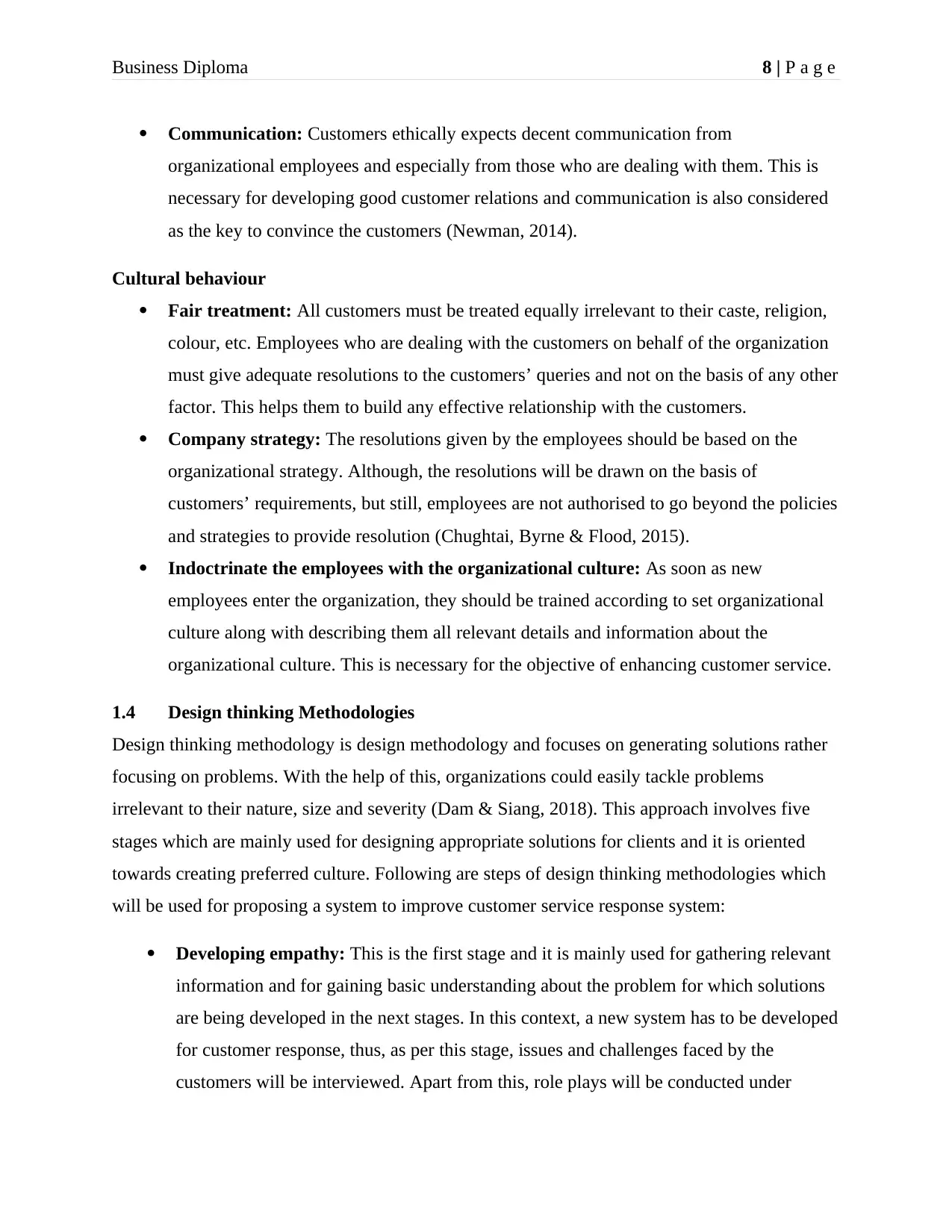
Business Diploma 8 | P a g e
Communication: Customers ethically expects decent communication from
organizational employees and especially from those who are dealing with them. This is
necessary for developing good customer relations and communication is also considered
as the key to convince the customers (Newman, 2014).
Cultural behaviour
Fair treatment: All customers must be treated equally irrelevant to their caste, religion,
colour, etc. Employees who are dealing with the customers on behalf of the organization
must give adequate resolutions to the customers’ queries and not on the basis of any other
factor. This helps them to build any effective relationship with the customers.
Company strategy: The resolutions given by the employees should be based on the
organizational strategy. Although, the resolutions will be drawn on the basis of
customers’ requirements, but still, employees are not authorised to go beyond the policies
and strategies to provide resolution (Chughtai, Byrne & Flood, 2015).
Indoctrinate the employees with the organizational culture: As soon as new
employees enter the organization, they should be trained according to set organizational
culture along with describing them all relevant details and information about the
organizational culture. This is necessary for the objective of enhancing customer service.
1.4 Design thinking Methodologies
Design thinking methodology is design methodology and focuses on generating solutions rather
focusing on problems. With the help of this, organizations could easily tackle problems
irrelevant to their nature, size and severity (Dam & Siang, 2018). This approach involves five
stages which are mainly used for designing appropriate solutions for clients and it is oriented
towards creating preferred culture. Following are steps of design thinking methodologies which
will be used for proposing a system to improve customer service response system:
Developing empathy: This is the first stage and it is mainly used for gathering relevant
information and for gaining basic understanding about the problem for which solutions
are being developed in the next stages. In this context, a new system has to be developed
for customer response, thus, as per this stage, issues and challenges faced by the
customers will be interviewed. Apart from this, role plays will be conducted under
Communication: Customers ethically expects decent communication from
organizational employees and especially from those who are dealing with them. This is
necessary for developing good customer relations and communication is also considered
as the key to convince the customers (Newman, 2014).
Cultural behaviour
Fair treatment: All customers must be treated equally irrelevant to their caste, religion,
colour, etc. Employees who are dealing with the customers on behalf of the organization
must give adequate resolutions to the customers’ queries and not on the basis of any other
factor. This helps them to build any effective relationship with the customers.
Company strategy: The resolutions given by the employees should be based on the
organizational strategy. Although, the resolutions will be drawn on the basis of
customers’ requirements, but still, employees are not authorised to go beyond the policies
and strategies to provide resolution (Chughtai, Byrne & Flood, 2015).
Indoctrinate the employees with the organizational culture: As soon as new
employees enter the organization, they should be trained according to set organizational
culture along with describing them all relevant details and information about the
organizational culture. This is necessary for the objective of enhancing customer service.
1.4 Design thinking Methodologies
Design thinking methodology is design methodology and focuses on generating solutions rather
focusing on problems. With the help of this, organizations could easily tackle problems
irrelevant to their nature, size and severity (Dam & Siang, 2018). This approach involves five
stages which are mainly used for designing appropriate solutions for clients and it is oriented
towards creating preferred culture. Following are steps of design thinking methodologies which
will be used for proposing a system to improve customer service response system:
Developing empathy: This is the first stage and it is mainly used for gathering relevant
information and for gaining basic understanding about the problem for which solutions
are being developed in the next stages. In this context, a new system has to be developed
for customer response, thus, as per this stage, issues and challenges faced by the
customers will be interviewed. Apart from this, role plays will be conducted under
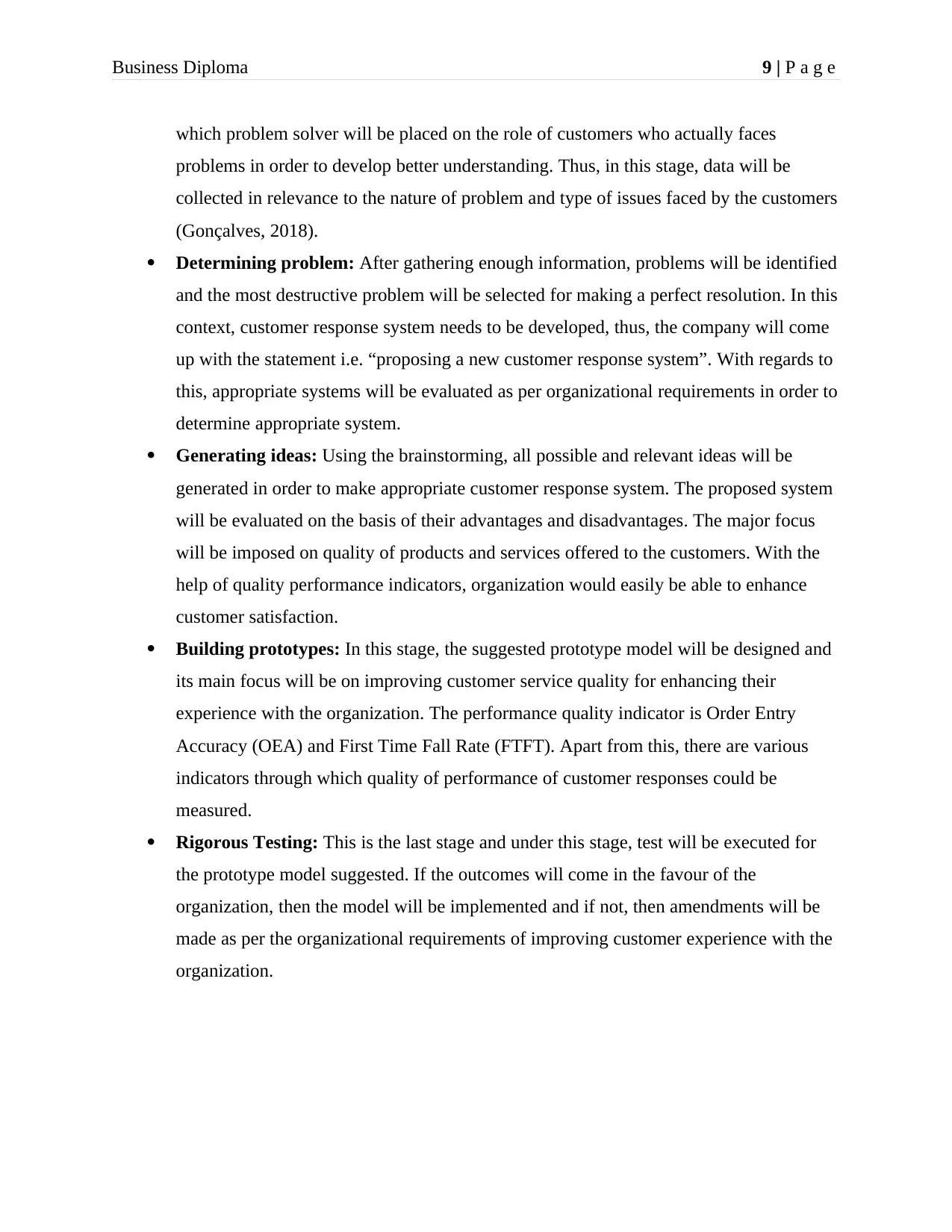
Business Diploma 9 | P a g e
which problem solver will be placed on the role of customers who actually faces
problems in order to develop better understanding. Thus, in this stage, data will be
collected in relevance to the nature of problem and type of issues faced by the customers
(Gonçalves, 2018).
Determining problem: After gathering enough information, problems will be identified
and the most destructive problem will be selected for making a perfect resolution. In this
context, customer response system needs to be developed, thus, the company will come
up with the statement i.e. “proposing a new customer response system”. With regards to
this, appropriate systems will be evaluated as per organizational requirements in order to
determine appropriate system.
Generating ideas: Using the brainstorming, all possible and relevant ideas will be
generated in order to make appropriate customer response system. The proposed system
will be evaluated on the basis of their advantages and disadvantages. The major focus
will be imposed on quality of products and services offered to the customers. With the
help of quality performance indicators, organization would easily be able to enhance
customer satisfaction.
Building prototypes: In this stage, the suggested prototype model will be designed and
its main focus will be on improving customer service quality for enhancing their
experience with the organization. The performance quality indicator is Order Entry
Accuracy (OEA) and First Time Fall Rate (FTFT). Apart from this, there are various
indicators through which quality of performance of customer responses could be
measured.
Rigorous Testing: This is the last stage and under this stage, test will be executed for
the prototype model suggested. If the outcomes will come in the favour of the
organization, then the model will be implemented and if not, then amendments will be
made as per the organizational requirements of improving customer experience with the
organization.
which problem solver will be placed on the role of customers who actually faces
problems in order to develop better understanding. Thus, in this stage, data will be
collected in relevance to the nature of problem and type of issues faced by the customers
(Gonçalves, 2018).
Determining problem: After gathering enough information, problems will be identified
and the most destructive problem will be selected for making a perfect resolution. In this
context, customer response system needs to be developed, thus, the company will come
up with the statement i.e. “proposing a new customer response system”. With regards to
this, appropriate systems will be evaluated as per organizational requirements in order to
determine appropriate system.
Generating ideas: Using the brainstorming, all possible and relevant ideas will be
generated in order to make appropriate customer response system. The proposed system
will be evaluated on the basis of their advantages and disadvantages. The major focus
will be imposed on quality of products and services offered to the customers. With the
help of quality performance indicators, organization would easily be able to enhance
customer satisfaction.
Building prototypes: In this stage, the suggested prototype model will be designed and
its main focus will be on improving customer service quality for enhancing their
experience with the organization. The performance quality indicator is Order Entry
Accuracy (OEA) and First Time Fall Rate (FTFT). Apart from this, there are various
indicators through which quality of performance of customer responses could be
measured.
Rigorous Testing: This is the last stage and under this stage, test will be executed for
the prototype model suggested. If the outcomes will come in the favour of the
organization, then the model will be implemented and if not, then amendments will be
made as per the organizational requirements of improving customer experience with the
organization.
⊘ This is a preview!⊘
Do you want full access?
Subscribe today to unlock all pages.

Trusted by 1+ million students worldwide
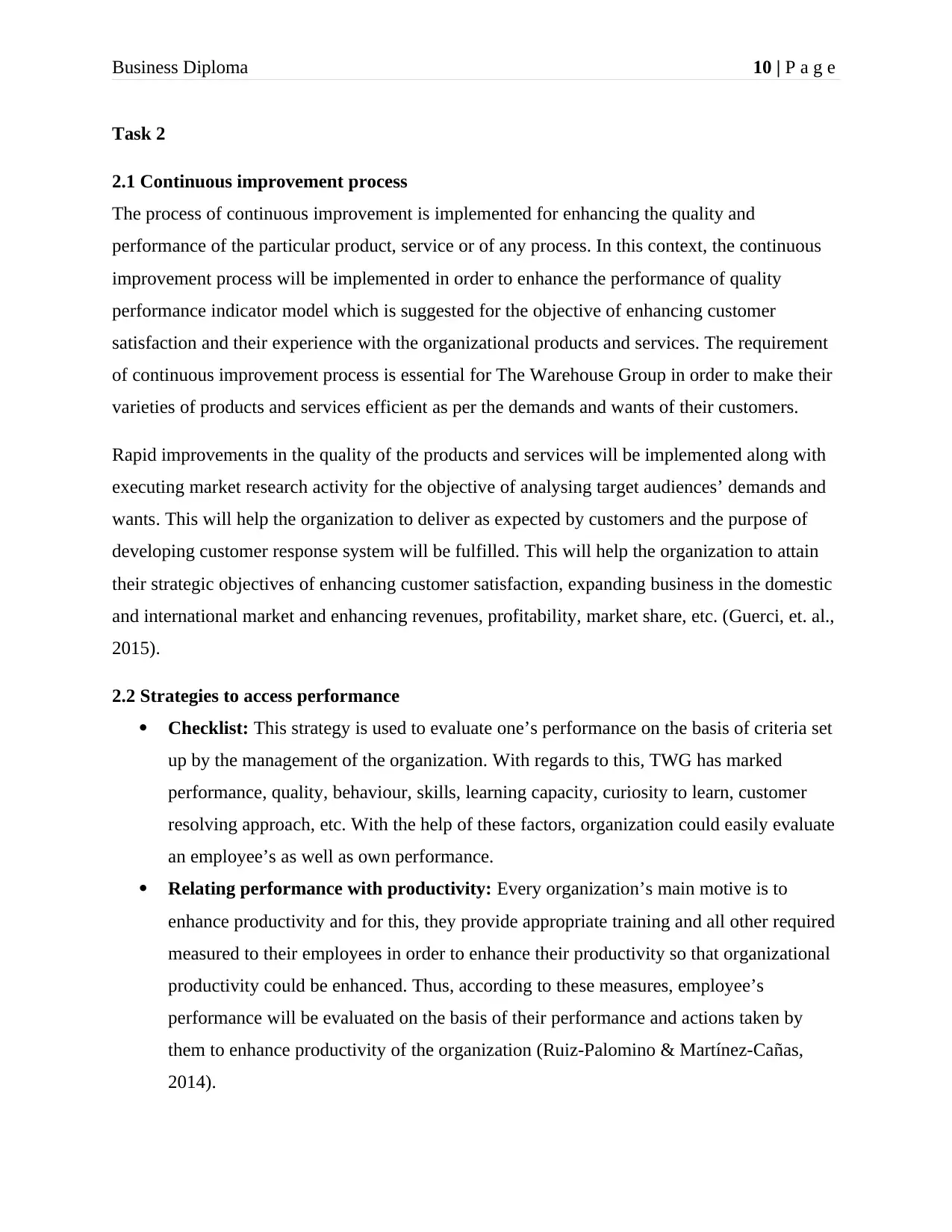
Business Diploma 10 | P a g e
Task 2
2.1 Continuous improvement process
The process of continuous improvement is implemented for enhancing the quality and
performance of the particular product, service or of any process. In this context, the continuous
improvement process will be implemented in order to enhance the performance of quality
performance indicator model which is suggested for the objective of enhancing customer
satisfaction and their experience with the organizational products and services. The requirement
of continuous improvement process is essential for The Warehouse Group in order to make their
varieties of products and services efficient as per the demands and wants of their customers.
Rapid improvements in the quality of the products and services will be implemented along with
executing market research activity for the objective of analysing target audiences’ demands and
wants. This will help the organization to deliver as expected by customers and the purpose of
developing customer response system will be fulfilled. This will help the organization to attain
their strategic objectives of enhancing customer satisfaction, expanding business in the domestic
and international market and enhancing revenues, profitability, market share, etc. (Guerci, et. al.,
2015).
2.2 Strategies to access performance
Checklist: This strategy is used to evaluate one’s performance on the basis of criteria set
up by the management of the organization. With regards to this, TWG has marked
performance, quality, behaviour, skills, learning capacity, curiosity to learn, customer
resolving approach, etc. With the help of these factors, organization could easily evaluate
an employee’s as well as own performance.
Relating performance with productivity: Every organization’s main motive is to
enhance productivity and for this, they provide appropriate training and all other required
measured to their employees in order to enhance their productivity so that organizational
productivity could be enhanced. Thus, according to these measures, employee’s
performance will be evaluated on the basis of their performance and actions taken by
them to enhance productivity of the organization (Ruiz-Palomino & Martínez-Cañas,
2014).
Task 2
2.1 Continuous improvement process
The process of continuous improvement is implemented for enhancing the quality and
performance of the particular product, service or of any process. In this context, the continuous
improvement process will be implemented in order to enhance the performance of quality
performance indicator model which is suggested for the objective of enhancing customer
satisfaction and their experience with the organizational products and services. The requirement
of continuous improvement process is essential for The Warehouse Group in order to make their
varieties of products and services efficient as per the demands and wants of their customers.
Rapid improvements in the quality of the products and services will be implemented along with
executing market research activity for the objective of analysing target audiences’ demands and
wants. This will help the organization to deliver as expected by customers and the purpose of
developing customer response system will be fulfilled. This will help the organization to attain
their strategic objectives of enhancing customer satisfaction, expanding business in the domestic
and international market and enhancing revenues, profitability, market share, etc. (Guerci, et. al.,
2015).
2.2 Strategies to access performance
Checklist: This strategy is used to evaluate one’s performance on the basis of criteria set
up by the management of the organization. With regards to this, TWG has marked
performance, quality, behaviour, skills, learning capacity, curiosity to learn, customer
resolving approach, etc. With the help of these factors, organization could easily evaluate
an employee’s as well as own performance.
Relating performance with productivity: Every organization’s main motive is to
enhance productivity and for this, they provide appropriate training and all other required
measured to their employees in order to enhance their productivity so that organizational
productivity could be enhanced. Thus, according to these measures, employee’s
performance will be evaluated on the basis of their performance and actions taken by
them to enhance productivity of the organization (Ruiz-Palomino & Martínez-Cañas,
2014).
Paraphrase This Document
Need a fresh take? Get an instant paraphrase of this document with our AI Paraphraser
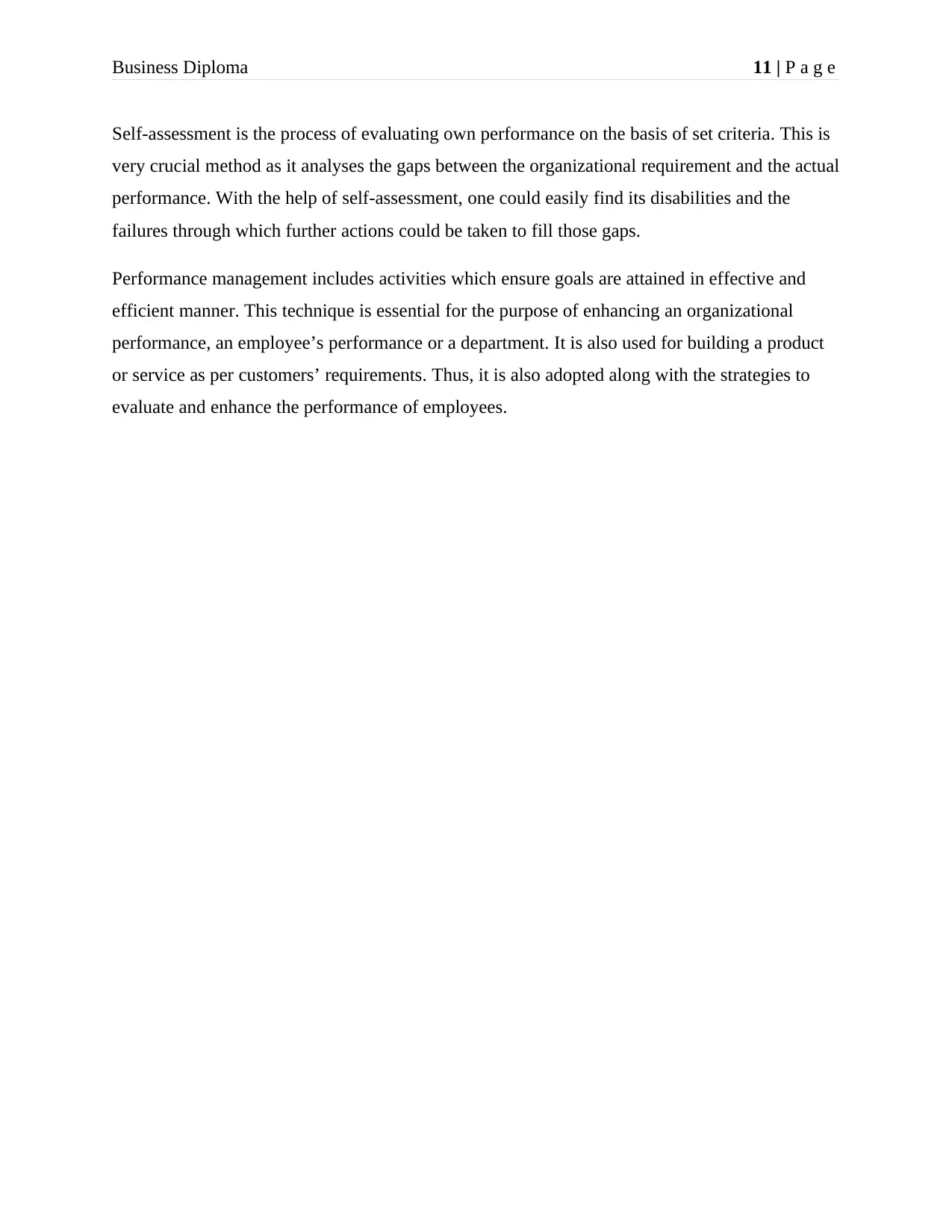
Business Diploma 11 | P a g e
Self-assessment is the process of evaluating own performance on the basis of set criteria. This is
very crucial method as it analyses the gaps between the organizational requirement and the actual
performance. With the help of self-assessment, one could easily find its disabilities and the
failures through which further actions could be taken to fill those gaps.
Performance management includes activities which ensure goals are attained in effective and
efficient manner. This technique is essential for the purpose of enhancing an organizational
performance, an employee’s performance or a department. It is also used for building a product
or service as per customers’ requirements. Thus, it is also adopted along with the strategies to
evaluate and enhance the performance of employees.
Self-assessment is the process of evaluating own performance on the basis of set criteria. This is
very crucial method as it analyses the gaps between the organizational requirement and the actual
performance. With the help of self-assessment, one could easily find its disabilities and the
failures through which further actions could be taken to fill those gaps.
Performance management includes activities which ensure goals are attained in effective and
efficient manner. This technique is essential for the purpose of enhancing an organizational
performance, an employee’s performance or a department. It is also used for building a product
or service as per customers’ requirements. Thus, it is also adopted along with the strategies to
evaluate and enhance the performance of employees.
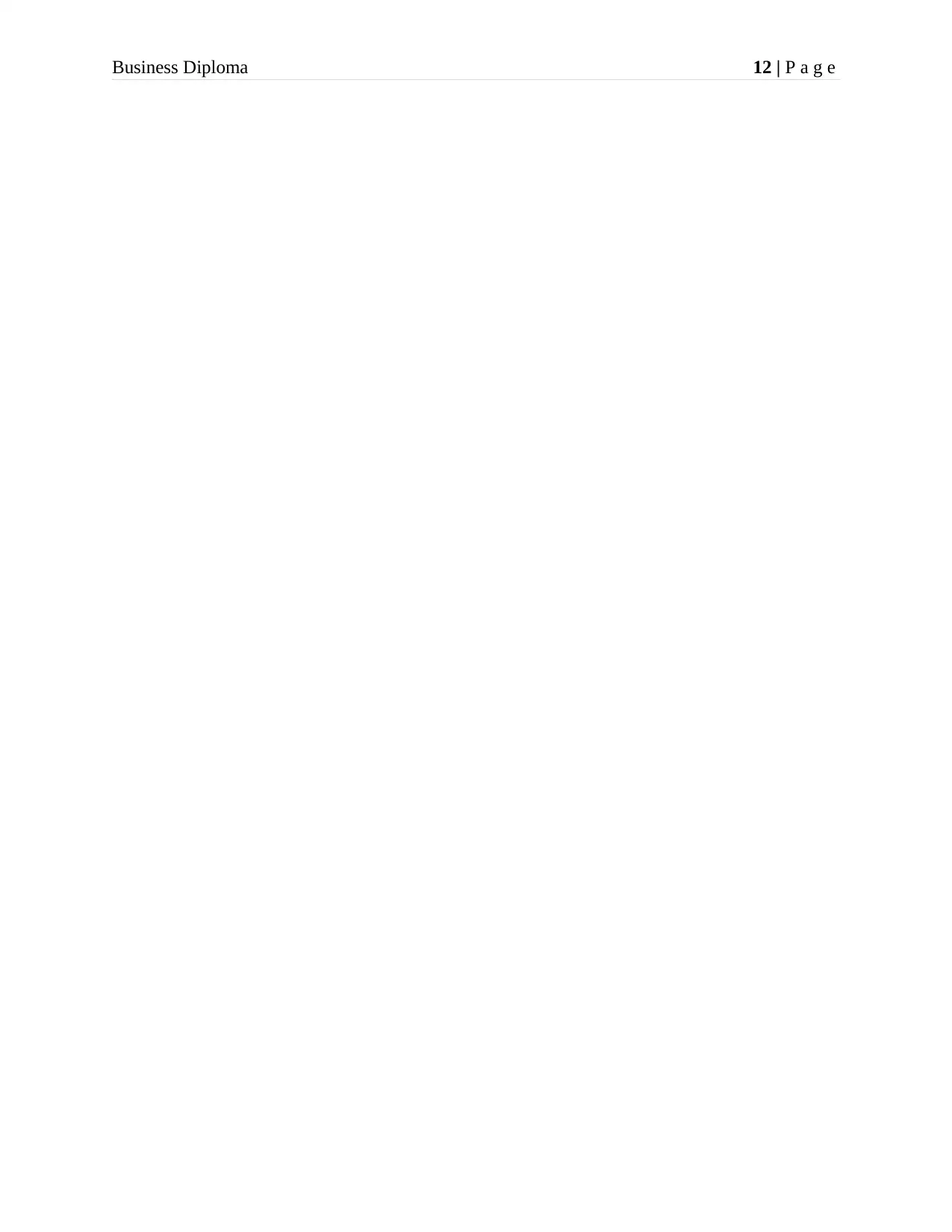
Business Diploma 12 | P a g e
⊘ This is a preview!⊘
Do you want full access?
Subscribe today to unlock all pages.

Trusted by 1+ million students worldwide
1 out of 15
Related Documents
Your All-in-One AI-Powered Toolkit for Academic Success.
+13062052269
info@desklib.com
Available 24*7 on WhatsApp / Email
![[object Object]](/_next/static/media/star-bottom.7253800d.svg)
Unlock your academic potential
Copyright © 2020–2025 A2Z Services. All Rights Reserved. Developed and managed by ZUCOL.





